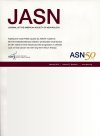A Small Molecule Agonist of Krüppel-Like Factor 15 in Proteinuric Kidney Disease
A human podocyte-based high-throughput screen identified a novel agonist of Krüppel-like factor 15 (BT503), independent of glucocorticoid signaling.BT503 demonstrated renoprotective effects in three independent proteinuric kidney murine models.BT503 directly binds to inhibitor of nuclear factor kappa-B kinase subunit beta to inhibit NF-κB activation, which, subsequently restores Krüppel-like factor 15 under cell stress.
Background
Podocyte loss is the major driver of primary glomerular diseases such as FSGS. While systemic glucocorticoids remain the initial and primary therapy for these diseases, high-dose and chronic use of glucocorticoids is riddled with systemic toxicities. Krüppel-like factor 15 (KLF15) is a glucocorticoid-responsive gene, which is essential for the restoration of mature podocyte differentiation markers and stabilization of actin cytoskeleton in the setting of cell stress. Induction of KLF15 attenuates podocyte injury and glomerulosclerosis in the setting of cell stress.
Methods
A cell-based high-throughput screen with a subsequent structure–activity relationship study was conducted to identify novel agonists of KLF15 in human podocytes. Next, the agonist was tested in cultured human podocytes under cell stress and in three independent proteinuric models (LPS, nephrotoxic serum nephritis, and HIV-1 transgenic mice). A combination of RNA sequencing and molecular modeling with experimental validation was conducted to demonstrate the direct target of the agonist.
Results
The high-throughput screen with structure–activity relationship study identified BT503, a urea-based compound, as a novel agonist of KLF15, independent of glucocorticoid signaling. BT503 demonstrated protective effects in cultured human podocytes and in three independent proteinuric murine models. Subsequent molecular modeling with experimental validation shows that BT503 targets the inhibitor of nuclear factor kappa-B kinase complex by directly binding to inhibitor of nuclear factor kappa-B kinase subunit beta to inhibit canonical NF-κB signaling, which, in turn, restores KLF15 under cell stress, thereby rescuing podocyte loss and ameliorating kidney injury.
Conclusions
By developing and validating a cell-based high-throughput screen in human podocytes, we identified a novel agonist for KLF15 with salutary effects in proteinuric murine models through direct inhibition of inhibitor of nuclear factor kappa-B kinase subunit beta kinase activity.




